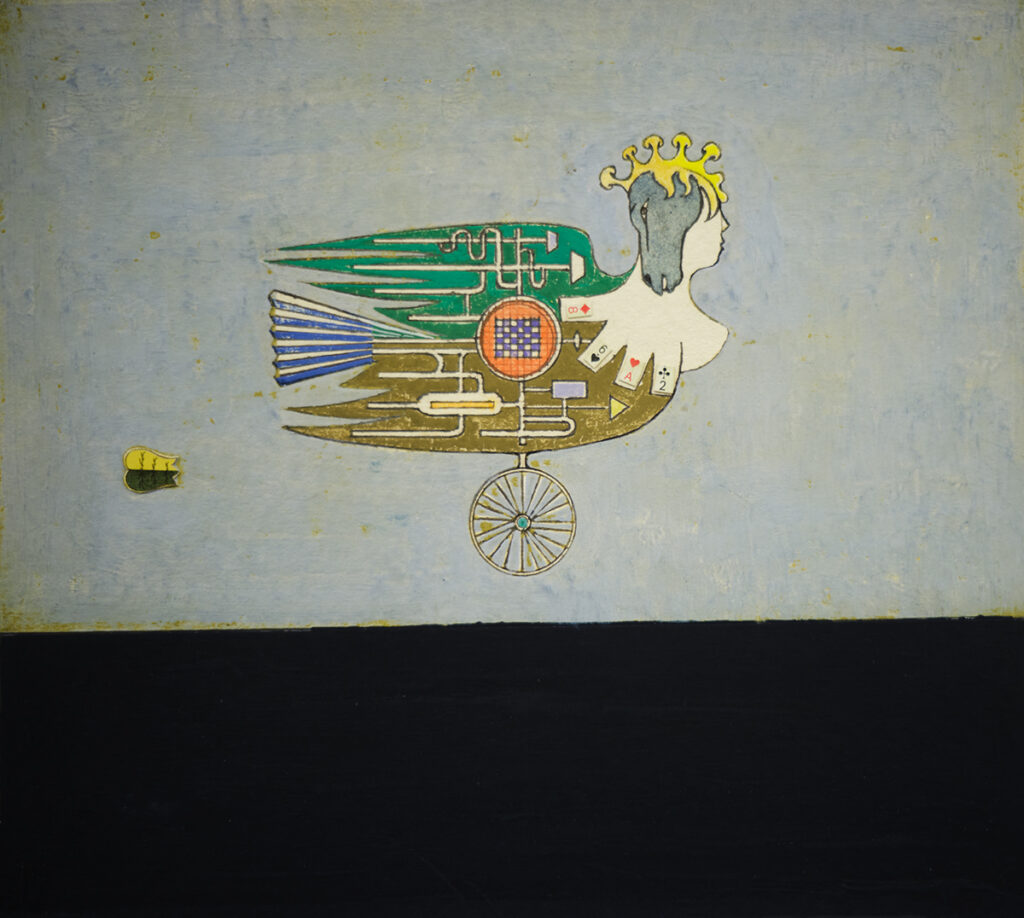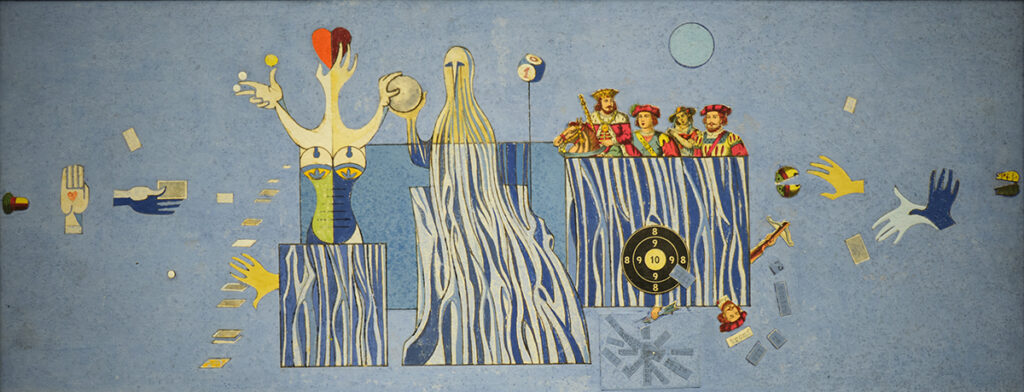

The Nitra Gallery collection includes 19 works by Ladislav Guderna. This virtual gallery text describes two of the artist’s paintings (design proposals) related to the legendary Expo 67 in Montreal. The Canadian convention was one of the most historically significant presentations of Czechoslovakia. The exhibition focused on the artistic factor of the presentation as well as the purpose of presenting our culture, with the Czechoslovak Pavilion being one of the most reflected ones (Czechoslovakia had already presented itself at other world expos, e.g. the Brussels Expo ’58, the Osaka Expo ’70). [1] Unfortunately, not much of the originally presented material has been preserved. Most of the artworks and design fixtures have remained in Canada and we can reflect on the exhibition only with written documentation, design proposals, original sketches and photographs. The few remaining pieces left were used to create a project by Slovak Design Center titled Exhibitionmat: the Czechoslovak Pavilion at Expo 67 Montreal (Satelit Gallery SDC, 2018). [2] Many artists from different branches participated at the exhibition.
Ladislav Guderna presented his wall paintings (stuccos). The exhibition design proposals reflect the artist’s approach. Ladislav Guderna started to work with collages in the 1960s. He used image clippings, changed their original purpose and incorporated them into his made-up fantasy world. The artist’s language utilises his sometimes even decadent approach to history, irony, pleasantness, stillness, metaphor and peace. He creates space without time. His works often feature sensual headless bodies and bodiless heads full of mystery. “Guderna’s world is full of various female heads that fill its emptiness with joy and humour and create an antipode to the male principle and sometimes they even create their own, often misunderstood world.” [3] Guderna’s women are sometimes dressed, other times they are naked, but they are always aware of their feminity, even when the artist loses their heads and replaces them with a heart, an animal, zoomorphic or other motive (O -194 Design Proposal for Montreal, 1966). And when he finds the missing head, he puts it on an electric torso of a cycle-dove and props its hair with a horse-face crown (O – 436 Proposed Wall Design for the Czechoslovak Pavilion at the World Expo in Montreal 1964-1965). The proposed designs carry traces of decorativism, refinement and wit and connect seemingly unrelated things with the easiness of a large number of connotations. “Ladislav Guderna decorated the walls of the Old Prague’s Restaurant with fantasy-like colourful stucco illustrating a motive of card games that elaborated on the traditional interest of the Czechoslovak modern art in surrealism. The authors of the interior of the so-called Slovak Restaurant (the correct title is the Bratislava Restaurant or simply Bratislava) were architects Vojtech Vilhan and Ferdinand Milučký. They were inspired by the synthesis of functionalism and elements of the Slovak folk art and architecture. The restaurant interior incorporated many references to folk architecture and art, particularly in utilising wood furniture, in the tectonics of the restaurant’s massive joists and the walls made of planks.” [4]
— Ľudmila Kasaj Poláčková
Sources
[1] Available at: https://www.webumenia.sk/clanok/montreal-expo-67 (Accessed on May 10, 2021).
[2] More information about the SDC exhibition at: https://www.scd.sk/?vystavy-satelit&sprava=automat-na-vystavu-ceskoslovensky-pavilon-na-expo-67-v-montreale (Accessed on May 10, 2021).
[3] KISZ-SZÉMAN, ŽOFIA: Ladislav Guderna – Lietajúca ryba [Flying Fish]. Bratislava: GMB, 2012, p. 77.
[4] More information about EXPO MONTREAL 1967 available at: http://magdamag.sk/2017/11/08/slovencina-dejiny-ceskoslovensko-na-expo-67-v-montreale/ (Accessed on May 10, 2021).
https://www.youtube.com/watch?v=kDz3PK8RcS8 (Expo Montreal 1967 Documentary, Accessed on May 10, 2021).
Ladislav Guderna (June 1, 1921 Nitra – October 6, 1999 Vancouver) is one of the key Slovak surrealists. He studied at the School of Applied Arts under Ľ. Fulla. From 1938, he studied at Maximilián Schurmann’s private painting school, which was later operated by the Slovak University of Technology in Bratislava where Guderna studied under prof. J. Mudroch and M. Benka. In 1944, he studied at the Academy of Arts in Belgrade. He was particularly interested in the theory of painting and cooperated with surrealistic poets (Avantgarde 38). Guderna’s cover designs and illustrations became a part of many anthologies. He was very interested in the relationship of the shape, content, form and expression.
After World War II, he was one of the founding members of the 29th August Artists Group. Guderna began to lean towards surrealism during the 1960s. His poetically designed compositions combined different materials. He became a member of Mánes in Prague. In 1946, he met his future partner Eva Pospíšilová. At the time, he was predominantly focused on using heavy black lines, clear shapes, dark colour palette and expressive tones. In the 1950s, he worked mostly on subtle portraits, figural pantings and still life. His pantings represented the imagination of a metaphysical landscape/still life. In 1957, he became the president of the Union of Slovak Fine Artists. His artistic designs have received several awards (honourable mentions, medals – e.g. Best Stamp Award 1965-1966).
After the Soviet occupation of Czechoslovakia in 1968, he emigrated to Canada as a sign of protest. He became a member of Canadian surrealistic groups West Coast Surrealists and Melmoth Vancouver Group. He was always open to new directions and inspirations. He focused predominantly on the metaphorical imaginative level. He would often come back to his earlier motives and reinterpret them from scratch. While in emigration, he would publish several magazines together with his son Martin: Scarabeus (1979 – 1998); Vancouver Surrealist Newsletter (1980 – 1981); Melmoth Vancouver (1981 – 1986).
Exhibitions: His first exhibition was a group exhibition (1941) with J. Šturdík, R. Pribiš, V. Chmel, and a year later with E. Semian and O. Dubay. He also participated at many international exhibitions: e.g. 1945 The Art of Czechoslovakia in Paris, Manes Generation 1939 – 1947, Prague; 1948 XXIV. Biennial, Venice; 1959 World EXPO ´58, the Brussels; 1960 Exhibition of the International Competition, Guggenheim Museum, New York; 1967 Wall paintings for the Czechoslovak Pavilion at EXPO ´67, Montreal; 1971 Surrealistic Explorers (Arp, Chagall, Dali, Guderna, Haquand, Matta, Miro, Ortega), Toronto; 1981 XVI. Biennale Sao Paulo; 1983 I. International Mail Art Exhibition, Soul; 1990 ARTOPOLIS ´90, Vancouver; 1991 Europäische Dialoge. Bochum, Museum Bochum; 1992 Actual Exhibition, Paris; 1996 Book an Q. Fifty years of correlations, Brno and many others.
His first solo exhibition was held in 1946 and his latest /postmortem/ one was at Bratislava City Gallery in 2012. Nitra Gallery will honour the artist’s work and the 100th anniversary of his birth with a surrealistic online exposition.
No.: O 436
Artist: Ladislav Guderna
Title: Proposed Wall Design for the Czechoslovak Pavilion at EXPO 67 in Montreal
Year of origin: 1964 – 1965
Technique: tempera
Material: cardboard
Dimensions: 25 x 27,5 cm
Signature: none
No.: O 194
Artist: Ladislav Guderna
Title: Design Proposal for Montreal
Year of origin: 1966
Technique: mixed media
Material: paper
Dimensions: 21,5 x 56,5 cm
Signature: none